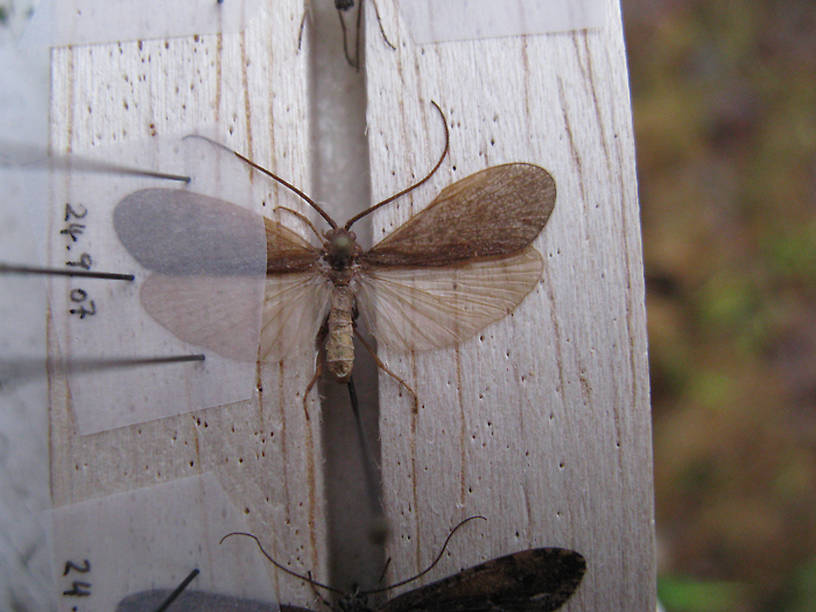Blog & Latest Updates
Fly Fishing Articles
Insects by Common Name


> > One more
| Taju | November 17th, 2008, 6:44 am | |
| Hartola, Finland Posts: 11 | Is it possible to determine this species at least to the genus level? | |
| Taju | November 17th, 2008, 6:48 am | |
| Hartola, Finland Posts: 11 | ....and it is from Kentucky, 24.9.2007. | |
| Creno | November 17th, 2008, 8:19 am | |
| Grants Pass, OR Posts: 305 | The rounded wings and relatively thick antennae look like Pseudostenophylax sparsus. But wing venation is out of focus so cannot be sure. | |
| Taju | November 17th, 2008, 8:46 am | |
| Hartola, Finland Posts: 11 | Are there any available pictures of the genitalia? My first thought was that it is like our Stenophylax-species (in Finland):) I suppose this is a common species? | |
| GONZO | November 17th, 2008, 9:54 am | |
Site Editor "Bear Swamp," PAPosts: 1681 | Creno, I remembered your comment about the thickness of P. sparsus antennae (made elsewhere), and given the limited choice of limnephilids represented in the collecting record for KY, P. sparsus seemed likely. My question: Other than the thickness of the antennae, what might help distinguish between (especially closed-wing) photos of Pseudostenophylax and Ironoquia? | |
| Creno | November 17th, 2008, 10:33 am | |
| Grants Pass, OR Posts: 305 | Gonzo - yours is a better memory than mine - I will have to go back and see what I said then. This could indeed be Ironoquia - the hind wing doesn't look quite deep enough. A clear picture of the forewing (or hindwing)venation may resolve the question. At least in NA I believe the origination of vein R2 on the discoidal cell is anterior of the "chord" a greater distance than the tallest height of the discoidal cell for Ironoquia. In Pseudostenophylax, the R2 origination is much closer to the "chord," less than the discoidal height. If you get a good photo of the forewing, or have the specimen in hand it is quite apparent. I have sent Taju a pm for his email and I can send him a figure of the genitalia. I will also send the Ironoquia and he should be able to readily see the difference. | |
| GONZO | November 17th, 2008, 10:41 am | |
Site Editor "Bear Swamp," PAPosts: 1681 | Thank you. :) | |
| Taju | November 18th, 2008, 6:04 am | |
| Hartola, Finland Posts: 11 | Thanks to the figures by Creno it is possible to ID the species as Ironoquia punctatissima (Walker, 1852). Thanks also to Gonzo :) | |
Quick Reply
You have to be logged in to post on the forum. It's this easy:
Related Discussions
| Title | Replies | Last Reply |
| Re: You all are nuts! In Male Neoleptophlebia adoptiva Mayfly Dun by VTBob | 17 | Apr 10, 2012 by Entoman |
| Re: Perlid identification assistance request In the Identify This! Board by Tsali | 9 | Jun 17, 2015 by Oldredbarn |
| Identification: not Limnephilus In Limnephilidae Caddisfly Larva by Litobrancha | 0 | |
| Re: Ptilostomis male genitalia In the Identify This! Board by Taju | 5 | Nov 16, 2008 by Creno |
| Re: Advice for a young fisherman In Beginner Help by Jaeger | 27 | Aug 16, 2011 by Sayfu |
| Re: re - a couple bugs........ In the Photography Board by Creno | 7 | May 12, 2008 by GONZO |
| Re: Here's two I could use some help with from East Tennessee! (1 more) In the Identify This! Board by BrettHRomer | 6 | May 8, 2008 by JOHNW |
| Re: Little J caddis? In the Identify This! Board by CaseyP | 9 | Dec 22, 2007 by Martinlf |
| Re: School me on thread In Fly Tying by Trowingflys | 1 | Dec 7, 2012 by Oldredbarn |
| Re: Insect Identification Caddisfly In the Identify This! Board by Dkuhn | 10 | Oct 1, 2008 by Creno |
Troutnut.com is copyright © 2004-2024 Jason
Neuswanger (email Jason). See my FAQ for information about use of my images.
 privacy policy
privacy policy

